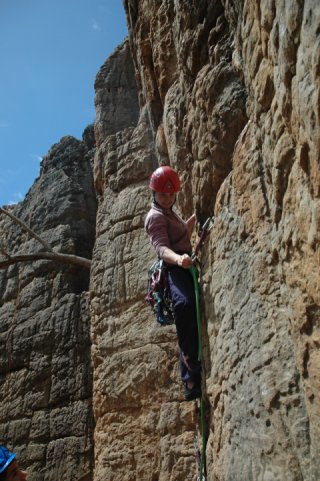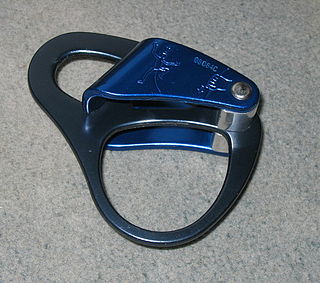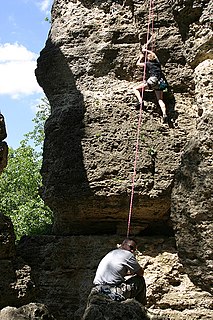
A Petzl Stop [1] is a descender used primarily in caving and formerly used for industrial rope access made by the French company Petzl.

A Petzl Stop [1] is a descender used primarily in caving and formerly used for industrial rope access made by the French company Petzl.
The Stop is for use with single low stretch kernmantle ropes and is usually attached to the harness via a carabiner. The rope is then threaded through the cam and bobbin by undoing the safety clip and moving the swinging side plate to the side. The swinging side plate facilitates insertion and removal of the rope without the need to disconnect it from the harness, making it less likely to be dropped while inserting and removing the rope from the Stop while at height. As the Stop is a self-braking descender, an unintentional release of the deadman's handle should stop the descent, due to the asymmetric lower cam crimping the rope. This functionality safeguards the user in the event of being knocked unconscious due to a rockfall or illness, though the fine control of rate of descent should be carried out by standard method of manually controlling friction with the hand on the rope below the descender.
A simpler version of the bobbin descender, without the stop handle, is also available. [2]

The Stop was updated for sale in 2019 replacing the original version. Changes to the design including updates to the dead man's handle, the bobbins and the carabiner slot. This version also saw Petzl shift the intended use of the Stop to recreational only use. The 2019 version of the Stop is no longer certified for Industrial use and Petzl now sell products such as the Petzl Rig and Petzl I'D S [3] for Industrial use instead.
Climbing protection is any of a variety of devices employed to reduce risk and protect others while climbing rock and ice. It includes such items as nylon webbing and metal nuts, cams, bolts, and pitons.

A climbing harness is a device which allows a climber access to the safety of a rope. It is used in rock and ice climbing, abseiling, and lowering; this is in contrast to other activities requiring ropes for access or safety such as industrial rope work, construction, and rescue and recovery, which use safety harnesses instead.

This glossary of climbing terms is a list of definitions of terms and jargon related to rock climbing and mountaineering. The specific terms used can vary considerably between different English-speaking countries; many of the phrases described here are particular to the United States and the United Kingdom.

A wide range of equipment is used during rock or any other type of climbing that includes equipment commonly used to protect a climber against the consequences of a fall.

Abseiling, also known as rappelling, is the controlled descent of a steep slope, such as a rock face, by moving down a rope. When abseiling the person descending controls their own movement down the rope, in contrast to lowering off in which the rope attached to the person descending is paid out by their belayer.

Free climbing is a form of rock climbing in which the climber may use climbing equipment such as ropes and other means of climbing protection, but only to protect against injury during falls and not to assist progress. The climber makes progress by using physical ability to move over the rock via handholds and footholds. Free climbing more specifically may include traditional climbing, sport climbing, bouldering and most forms of solo climbing. Free climbing a multi-pitch route means free-climbing each of its pitches in a single session. At the end of each pitch, climbers anchor themselves to belay stations where they can rest.
Self-locking devices are devices intended to arrest the fall of solo climbers who climb without partners. This device is used for back rope solo climbing for "ground-up climbing" or "top rope self belaying". To date, several types of such self-locking devices have evolved.

Belaying is a variety of techniques climbers use to create friction within a climbing system, particularly on a climbing rope, so that a falling climber does not fall very far. A climbing partner typically applies tension at the other end of the rope whenever the climber is not moving, and removes the tension from the rope whenever the climber needs more rope to continue climbing.

Lead climbing is a climbing style, predominantly used in rock climbing. In a roped party one climber has to take the lead while the other climbers follow. The lead climber wears a harness attached to a climbing rope, which in turn is connected to the other climbers below the lead climber. While ascending the route, the lead climber periodically connects the rope to protection equipment for safety in the event of a fall. This protection can consist of permanent bolts, to which the climber clips quickdraws, or removable protection such as nuts and cams. One of the climbers below the lead climber acts as a belayer. The belayer gives out rope while the lead climber ascends and also stops the rope when the lead climber falls or wants to rest.

The Munter hitch, also known as the Italian hitch, mezzo barcaiolo or the crossing hitch, is a simple adjustable knot, commonly used by climbers, cavers, and rescuers to control friction in a life-lining or belay system. To climbers, this hitch is also known as HMS, the abbreviation for the German term Halbmastwurfsicherung, meaning half clove hitch belay. This technique can be used with a special "pear-shaped" HMS locking carabiner, or any locking carabiner wide enough to take two turns of the rope.

An ascender is a device used for directly ascending a rope, or for facilitating protection with a fixed rope when climbing on very steep mountain terrain.
In rock climbing, an anchor can be any device or method for attaching a climber, a rope, or a load above or onto a climbing surface—typically rock, ice, steep dirt, or a building—either permanently or temporarily. The intention of an anchor is case-specific but is usually for fall protection, primarily fall arrest and fall restraint. Climbing anchors are also used for hoisting, holding static loads, or redirecting a rope.

Single-rope technique (SRT) is a set of methods used to descend and ascend on the same single rope. Single-rope technique is used in caving, potholing, rock climbing, canyoning, roped access for building maintenance and by arborists for tree climbing, although to avoid confusion in the tree climbing community, many have taken to calling it "stationary" rope technique.

A Reverso is a belay device developed and patented by Petzl, used for example in rock-climbing and other activities which involves rope-work. Another version of this device is the Reversino, intended for use with thinner ropes.

A climbing rope is a rope that is used in climbing. It is a critical part of an extensive chain of protective equipment used by climbers to help prevent potentially fatal fall-related accidents.

A dynamic rope is a specially constructed, somewhat elastic rope used primarily in rock climbing, ice climbing, and mountaineering. This elasticity, or stretch, is the property that makes the rope dynamic—in contrast to a static rope that has only slight elongation under load. Greater elasticity allows a dynamic rope to more slowly absorb the energy of a sudden load, such from arresting a climber's fall, by reducing the peak force on the rope and thus the probability of the rope's catastrophic failure. A kernmantle rope is the most common type of dynamic rope now used. Since 1945, nylon has, because of its superior durability and strength, replaced all natural materials in climbing rope.

A Grigri is an assisted braking belay device manufactured by Petzl designed to help secure rock-climbing, rappelling, and rope-acrobatic activities. Its main characteristic is a clutch that assists in braking under a shock load. The success of this device has led to grigri becoming a common name for devices of this type. In 2011 a new version, the Grigri 2, was released to replace the original 1991 model. Petzl released the Grigri+ in 2017, adding safety features to the original design, and 2019 saw the release of an updated version of the device, simply called the Grigri.

A belay device is a mechanical piece of climbing equipment used to control a rope during belaying. It is designed to improve belay safety for the climber by allowing the belayer to manage their duties with minimal physical effort. With the right belay device, a small, weak climber can easily arrest the fall of a much heavier partner. Belay devices act as a friction brake, so that when a climber falls with any slack in the rope, the fall is brought to a stop.

Caving equipment is equipment used by cavers and speleologists to aid and protect them while exploring caves. The term may also be used to refer to equipment used to document caves, such as photographic and surveying equipment. Originally, cave diving equipment was quite limited, but the increasing popularity of caving during the 20th century led to the creation of specialist caving equipment and companies.
{{cite web}}: CS1 maint: archived copy as title (link)